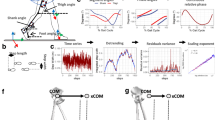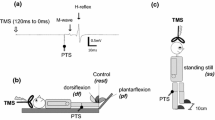Abstract
The present experiments were designed to gain additionally insight into how the spinal networks process direct spinal stimulation and peripheral sensory inputs to control posture and locomotor movements. We have developed a plantar pressure stimulation system that can deliver naturalistic postural and gait-related patterns of pressure to the soles of the feet to simulate standing and walking, thereby activating and/or modulating the automated spinal circuitry responsible for standing and locomotion. In the present study we compare the patterns of activation among selected motor pools and the kinematic consequences of these activation patterns in response to patterned heel-to-toe mechanical stimulation of the soles of the feet, and/or transcutaneous electrical spinal stimulation, for postural and locomotion regulation. The studies were performed in healthy individuals (n = 12) as well as in subjects (n = 2) with motor complete spinal cord injury. We found that plantar pressure stimulation and/or spinal stimulation can effectively facilitate locomotor output in the subjects placed with their legs in gravity neutral position. We have shown synergistic effects of combining sensory and spinal cord stimulation, suggesting that the two networks are different, but complementary. Also we provide evidence that plantar stimulation could serve as a novel neuro-rehabilitation tool alone or as part of a multi-modal approach to restoring motor function after complete paralysis due to SCI.
Similar content being viewed by others
References
Gerasimenko, Y., Transcutaneous electrical spinalcord stimulation in humans, Ann. Phys. Rehabil. Med., 2015, vol. 58, no. 4, p. 225.
Kozlovskaya, I.B. et al., Role of support afferentation in control of the tonic muscle activity, Acta Astronaut., 2007, vol. 60, nos. 4-7, p. 285.
Grigor'ev, A.I., Kozlovskaia, I.B., and Shenkman, B.S., The role of support afferents in organisation of the tonic muscle system, Ross. Fiziol. Zh. im. I.M. Sechenova, 2004, vol. 90, no. 5, p. 508
Tomilovskaya, E.S. et al., Mechanical stimulation of the support zones of soles: The method of noninvasive activation of the stepping movement generators in humans, Hum. Physiol., 2013, no. 5, vol. 39, no. 5, p. 480.
Gerasimenko, Y. et al., Initiation and modulation of locomotor circuitry output with multisite transcutaneous electrical stimulation of the spinal cord in noninjured humans, J. Neurophysiol., 2015, vol. 113, no. 3, p. 834.
Fan, R.E. et al., A prototype haptic feedback system for lower-limb prostheses and sensory neuropathy, Stud. Health Technol. Inf., 2008, vol. 132, p. 115.
McKinney, Z., et al., Initial biomechanical evaluation of wearable tactile feedback system for gait rehabilitation in peripheral neuropathy, Stud. Health Technol. Inf., 2014, vol. 196, p. 271.
de Noordhout, A. et al., Percutaneous electrical stimulation of lumbosacral roots in man, J. Neurol., Neurosurg. Psychiatry, 1988, vol. 51, no. 2, p. 174.
Gurfinkel, V.S. et al., Locomotor-like movements evoked by leg muscle vibration in humans, Eur. J. Neurosci., 1998, vol. 10, no. 5, p. 1608.
Selionov, V.A. et al., Tonic central and sensory stimuli facilitate involuntary air-stepping in humans, J. Neurophysiol., 2009, vol. 101, no. 6, p. 2847.
Gerasimenko, Y.P. et al., Noninvasive reactivation of motor descending control after paralysis, J. Neurotrauma, 2015, vol. 32, no. 24, p. 1968.
Gerasimenko, Y.P. et al., Integration of sensory, spinal, and volitional descending inputs in regulation of human locomotion, J. Neurophysiol., 2016, vol. 116, no. 1, p. 98.
Gerasimenko, Y. et al., Novel and direct access to the human locomotor spinal circuitry, J. Neurosci., 2010, vol. 30, no. 10, p. 3700.
Sayenko, D.G. et al., Positive effect of balance training with visual feedback on standing balance abilities in people with incomplete spinal cord injury, Spinal Cord, 2010, vol. 48, no. 12, p. 886.
Sayenko, D.G. et al., Effects of balance training with visual feedback during mechanically unperturbed standing on postural corrective responses, Gait Posture, 2012, vol. 35, no. 2, p. 339.
Hubli, M. and Dietz, V., The physiological basis of neurorehabilitation-locomotor training after spinal cord injury, J. Neuroeng. Rehabil., 2013, vol. 10, no. 5, p. 1.
Gerasimenko, Y. et al., Feed-forwardness of spinal networks in posture and locomotion, Neuroscientist, 2017. doi 1073858416683681
Harkema, S. et al., Effect of epidural stimulation of the lumbosacral spinal cord on voluntary movement, standing, and assisted stepping after motor complete paraplegia: a case study, Lancet, 2011, vol. 377, no. 9781, p. 1938.
Angeli, C.A. et al., Altering spinal cord excitability enables voluntary movements after chronic complete paralysis in humans, Brain, 2014, vol. 137, part 5, p. 1394.
Author information
Authors and Affiliations
Corresponding author
Additional information
Published in Russian in Fiziologiya Cheloveka, 2017, Vol. 43, No. 5, pp. 6–16.
The article was translated by the authors.
Rights and permissions
About this article
Cite this article
Gerasimenko, Y.P., McKinney, Z., Sayenko, D.G. et al. Spinal and sensory neuromodulation of spinal neuronal networks in humans. Hum Physiol 43, 492–500 (2017). https://doi.org/10.1134/S0362119717050061
Received:
Published:
Issue Date:
DOI: https://doi.org/10.1134/S0362119717050061




